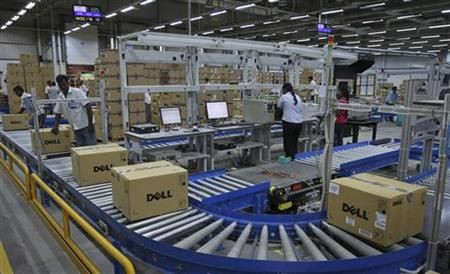HSBC’s India Manufacturing PMI For July Marginally Falls; Goldman Sachs Downgrades Indian Equity To Underweight

India’s manufacturing sector output dropped by a fraction -- its third straight fall in as many months -- but managed to stay above the 50-point mark, which divides growth from contraction, amid plunging new orders, a weakening economy, and a shortage of raw materials brought on by a weak rupee, an HSBC-Markit survey said on Thursday.
Also on Thursday, Goldman Sachs Group Inc (NYSE:GS) downgraded its rating on Indian stocks to “underweight” and recommended investors to only pick some select stocks citing an anemic recovery in growth, and measures taken by the Reserve Bank of India, or RBI, to halt the rupee's depreciation, which has tightened liquidity conditions, and other "macro vulnerabilities."
India’s Manufacturing Purchasing Managers’ Index, or PMI, was down to 50.1 in July compared to 50.3 in June, signaling continuing stagnation in manufacturing activity in the country, which has severely impacted the growth of its gross domestic product, or GDP.
“Of concern, inflation pressures firmed for both input and output prices, partly on the back of higher imported inflation due to the weaker currency. The data suggests that the RBI will likely have to keep policy rates on hold for a while given lingering inflation risks and that the recently introduced currency stabilization measures will not be lifted anytime soon,” Leif Eskesen, HSBC's chief economist for India and Southeast Asian nations, said in the report.
“Activity in the manufacturing sector was broadly flat in July. Output fell by less, but order flows weakened led by slower growth in export orders. Moreover, inventory accumulation and employment growth slowed,” Eskesen said.
New export orders rose for the 11th consecutive month in July, despite increased competition, but growth in export business in July was modest and the weakest in three months, despite the rupee having depreciated by more than 13 percent in the May to July period.
Meanwhile, Goldman Sachs, in a report, noted that Indian equities had seen scanty foreign-selling when compared to the massive foreign capital inflows in recent years, and predicted the rising risk of a potential “flow reversal” in equities, particularly in “crowded” financials.
The global investment bank said it "favored exporter-facing sectors, companies with strong balance sheet and thematic “alpha” trades." According to the report, the rupee will continue to be under pressure and the RBI will stick to its monetary policies tightening liquidity for the next 3-6 months.
“The recent activity data in Q2 2013 has been sluggish with no signs of a pick up in investment demand. Our current activity indicator (CAI) has slowed considerably over the past few months and industrial and infrastructure projects starts are showing no upturn,” Goldman Sachs said in the report. “We lower our NIFTY 12-month target to 6200, implying 7% upside in local FX with potential downside risks from INR weakness.”
The bank, which recently revised its forecasts for India’s GDP growth, downgrading it to 6 percent from 6.4 percent in the fiscal year ending in 2014, also called attention to India's rising current account deficit, which has moved up from 1 percent of FDP in 2007 to 4.8 percent in 2013. "We expect India’s current account to improve very gradually to 4.2% in FY14 and 3.4% in FY15,” the report said.
The report also mentioned "policy paralysis" ahead of the parliamentary elections, slated for 2014, as a key factor harming market sentiments, despite the government’s recent efforts to attract foreign investment.
© Copyright IBTimes 2024. All rights reserved.






















